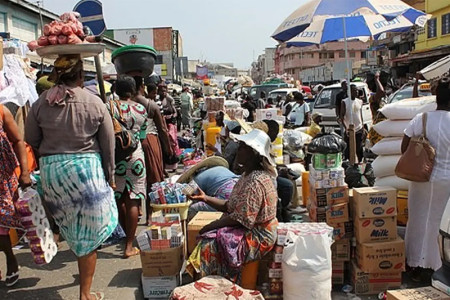This means that in the month of May 2023, the general price level was 42.2 per cent higher than in May 2022, Professor Samuel Kobina Annim, Government Statistician said at a media briefing in Kumasi on Wednesday.
He attributed the increase to a spike in food inflation during the period, which increased from 48.7 per cent in April to 51.8 per cent in May, which is the highest overall contribution to the national inflation rate in 17 months.
“Since January 2022, food inflation peaked in January 2023 with a rate of inflation of 61 per cent. This is more than three times the rate of food inflation which was recorded in January 2022 [13.7 per cent],” Prof Annim said.
He added: “Since January 2023, we saw a continuous slowdown in food inflation – decreasing through 59.1 per cent, 50 per cent to 48.7 per cent for April 2023.” The Government Statistician said that the decline in food inflation was reversed in May 2023 with an upward increase of up to 51.8 per cent.
Meanwhile, non-food inflation declined to 34.6 per cent in May 2023 from the 35.4 per cent recorded in April 2023.
A disaggregation of the May 2023 rate of inflation showed that inflation for locally produced items was 36.2 per cent, while that of imported items was 43.8 per cent.
On a divisional basis, furnishing and household equipment recorded the highest year-on-year inflation of 57.8 per cent, followed by housing, water, electricity, gas and other fuels, which had a 54 per cent inflation.
The year-on-year inflation for personal care, social protection and miscellaneous services was 53.4 per cent, food and non-alcoholic beverages – 51.8 per cent, and alcoholic beverages, tobacco and narcotics – 42.1 per cent.
The five divisions with the least inflation were restaurant and accommodation services – 5.9 per cent, insurance and financial services – 10.2 per cent, education – 10.5 per cent, information and communication – 16.1 per cent and recreation and culture – 29.2 per cent.
Regionally, the contribution of the Greater Accra region to the overall national inflation was the highest inflation – 24.6 per cent, followed by the Ashanti region, 17.2 per cent, Eastern region – 12.6 per cent, and Central region – 10.2 per cent.
The inflation recorded by the four regions combined – Greater Accra, Ashanti and Eastern (64.4 per cent) was more than half of the total inflation recorded among all 16 regions.
The 12 other regions all recorded inflation of less than 10 per cent, with five regions – Oti, Upper West, Ahafo, Savannah and North East, contributing inflation of less than two per cent to the overall national inflation.
GNA
By Francis Ntow


